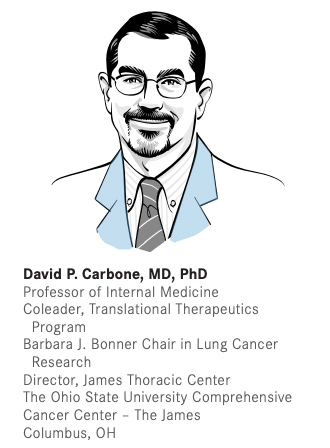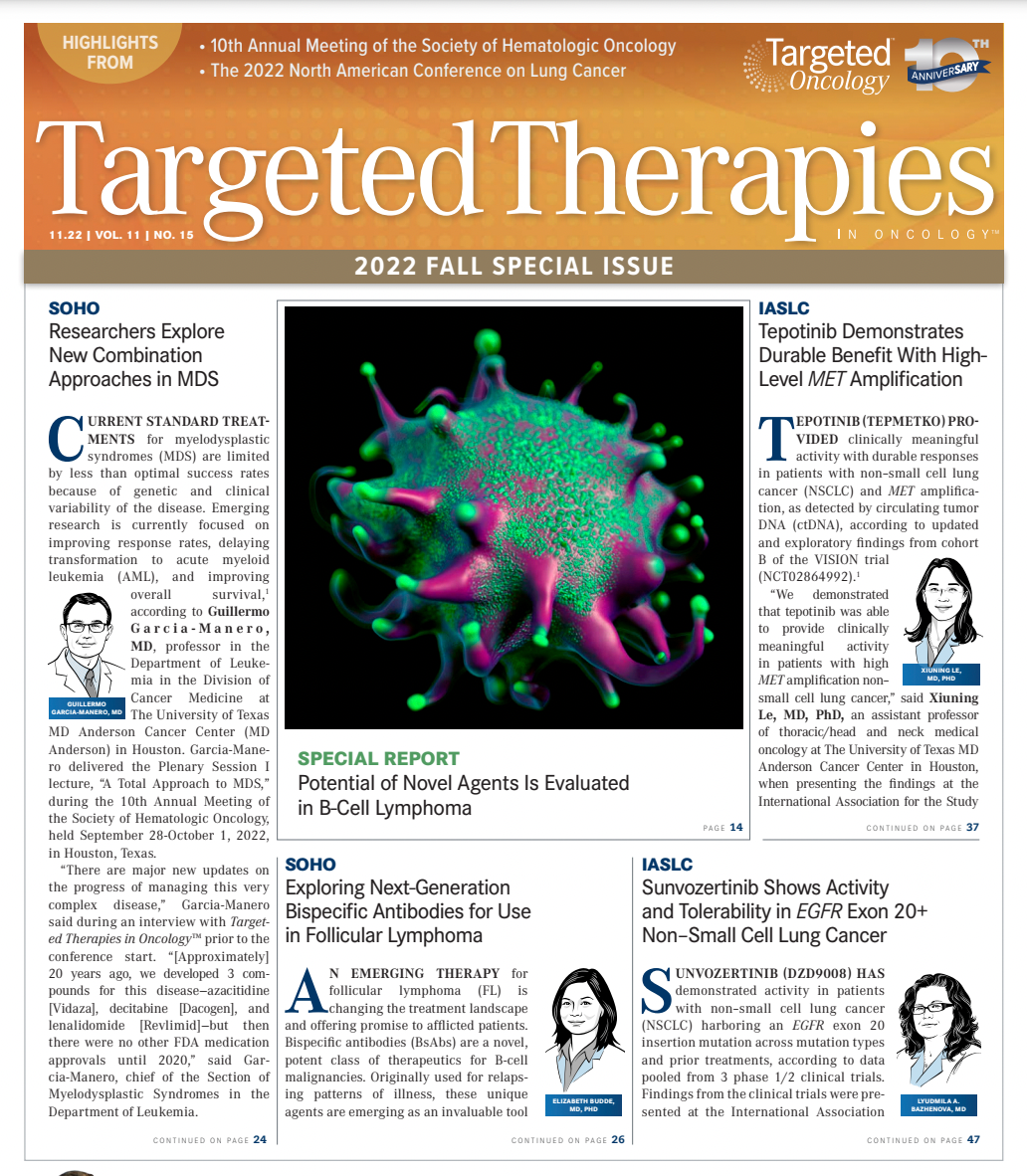Frontline Nivolumab/Ipilimumab + Chemotherapy Benefit Extends to Histology and PD-L1 Subgroups in mNSCLC
Updated data from the phase 3 CheckMate 9LA trial showed that the combination of nivolumab, ipilimumab, and 2 cycles of chemotherapy elicited survival benefit in patients with treatment-naïve metastatic non–small cell lung cancer.

Nivolumab (Opdivo) and ipilimumab (Yervoy) in combination with 2 cycles of chemotherapy continued to show long-term survival benefit in patients with treatment-naïve metastatic non–small cell lung cancer (mNSCLC), according to updated follow-up findings from the phase 3 CheckMate 9LA trial (NCT03215706).
At 3 years, the overall survival (OS) rates were 27% with the immunotherapy regimen compared with 19% with chemotherapy alone. Investigators observed the findings, presented at the International Association for the Study of Lung Cancer 2022 North America Conference on Lung Cancer, after a median follow-up of 35.2 months.1
Survival benefit and improvements in response rate and duration were also observed in subgroups of patients with positive or negative PD-L1 expression and in those with nonsquamous as well as squamous histology.
“These updated results further support nivolumab and ipilimumab and 2 cycles of chemotherapy as a first-line treatment option for patients with metastatic non–small cell lung cancer, regardless of tumor PD-L1 expression or histology,” said David P. Carbone, MD, PhD, coleader of the Translational Therapeutics Program, Barbara J. Bonner Chair in Lung Cancer Research, and director of the James Thoracic Center at The Ohio State University Comprehensive Cancer Center – The James.
Efficacy Outcomes by Subgroup
Earlier findings from CheckMate 9LA showed a median OS of 14.1 months in the immunotherapy arm compared with 10.7 months with chemotherapy (HR, 0.69; 96.71% CI, 0.55-0.87; P =.00065).2 These data supported the FDA approval in May 2020 for the regimen in patients with metastatic or recurrent NSCLC treated in the first-line disease setting who have no EGFR or ALK genomic aberrations.3
Updated OS findings showed a median of 15.8 months in the immunotherapy arm and 11.0 months in the chemotherapy arm (HR, 0.74; 95% CI, 0.62-0.87).
“Of note, this regimen has pretty much the same activity in both PD-L1–negative and PD-L1– positive patients,” Carbone said. In patients with positive PD-L1 expression, the median OS was 15.8 months with immunotherapy (n = 204) vs 10.9 months with chemotherapy (n = 204; HR, 0.74; 95% CI, 0.60-0.93). OS rates at 36 months were 28% and 19% in the immunotherapy and chemotherapy arms, respectively.
With negative PD-L1 expression, the median OS was 17.7 months with immunotherapy (n = 135) vs 9.8 months with chemotherapy (n = 129; HR, 0.67; 95% CI, 0.51-0.88). At 36 months, the OS rates were 25% and 15% in the immunotherapy and chemotherapy arms, respectively.
Rates were also similar in the positive PD-L1 expression groupings. Among patients with PD-L1 expression of 1% to 49%, the median OS was 15.2 months with immunotherapy (n = 128) vs 10.4 months with chemotherapy (n = 106; HR, 0.70; 95% CI, 0.53-0.93). OS rates at 36 months were 26% and 15% in the immunotherapy and chemotherapy arms, respectively.
In patients with 50% expression or more, the median OS was 18.9 months with immunotherapy (n = 76) vs 12.9 months with chemotherapy (n = 98; HR, 0.75; 95% CI, 0.53-1.07). At 36 months, the OS rates were 33% and 24% in the immunotherapy and chemotherapy arms, respectively.
“I think one of the more interesting aspects of the [ipilimumab/nivolumab] regimens is the activity in squamous vs nonsquamous [histology],” Carbone said. “Clearly there’s activity in both [histologies], but visually maybe [it’s] a little more impressive in squamous.”
In patients with nonsquamous histology, median OS was 17.8 months with immunotherapy (n = 246) vs 12.0 months with chemotherapy alone (n = 246; HR, 0.80; 95% CI, 0.65-0.98). The OS rates at 36 months were 28% and 23%, respectively.
Among patients with squamous histology, the median OS was 14.5 months with immunotherapy (n = 115) compared with 9.1 months with chemotherapy (n = 112; HR, 0.64; 95% CI, 0.48-0.86). At 36 months, the OS rates were 24% and 11% in the immunotherapy and chemotherapy arms, respectively.
Updated median progression-free survival (PFS) was 6.4 months with nivolumab/ ipilimumab/chemotherapy and 5.3 months with chemotherapy (HR, 0.70; 95% CI, 0.59- 0.83). At 3 years, the PFS rates were 13% with immunotherapy and 5% with chemotherapy. Rates were relatively similar by PD-L1 expression, with a median PFS of 5.8 months and 5.0 months in the immunotherapy and chemotherapy arms, respectively, in patients with negative PD-L1 expression (HR, 0.69; 95% CI, 0.52-0.91), and 6.9 months and 4.7 months in those with positive PD-L1 expression (HR, 0.71; 95% CI, 0.57-0.88).
By nonsquamous histology, median PFS was 6.9 months with immunotherapy compared with 5.6 months with chemotherapy (HR, 0.75; 95% CI, 0.61-0.92). In patients with squamous histology, the median PFS was 5.6 months with immunotherapy vs 4.3 months with chemotherapy (HR, 0.64; 95% CI, 0.48-0.86).
The objective response rate (ORR) in the overall population was 38% (95% CI, 33%- 43%) in the immunotherapy arm and 25% (95% CI, 21%-30%) in the chemotherapy arm.
In those with negative PD-L1 expression, ORRs were 32% in the immunotherapy arm and 20% in the chemotherapy arm. In the positive-expression group, the ORRs were 42% and 28% in the immunotherapy and chemotherapy arms, respectively. ORR by histology showed a 33% response rate with immunotherapy and 22% with chemotherapy in the nonsquamous population compared with ORRs of 49% and 31%, respectively, for the squamous population.
Median duration of response (DOR) in the overall population was 12.4 months (95% CI, 8.7-20.1) with nivolumab/ipilimumab/chemotherapy compared with 5.6 months (95% CI, 4.4-7.2) with chemotherapy alone. At 3 years or more, responses were ongoing in 23% (95% CI, 15%-31%) compared with 14% (95% CI, 8%-23%) of patients in the immunotherapy and chemotherapy arms, respectively.
By PD-L1 expression, the median DOR in those with negative expression was 17.5 months in the immunotherapy arm compared with 4.3 months in the chemotherapy arm. Responses were ongoing after at least 3 years in 37% and 0% of patients, respectively. In those with positive expression, the median DOR was 11.3 months with immunotherapy treatment compared with 5.6 months with chemotherapy alone, and responses were ongoing in 18% and 17% of patients, respectively.
By histology, the median DOR in the nonsquamous population was 17.5 months in the immunotherapy arm compared with 7.5 months in the chemotherapy arm. Responses were ongoing after 3 years or more in 27% and 20% of patients, respectively. In the squamous population, the median DOR was 10.8 months with immunotherapy treatment compared with 3.9 months with chemotherapy alone, and responses were ongoing in 17% and 6% of patients, respectively.
The median duration of treatment was 6.1 months (range, 0-24.4) with nivolumab and ipilimumab in combination with limited chemotherapy compared with 2.5 months (range, 0-46.1) with chemotherapy alone. In the investigational arm, patients received an average of 9 doses of nivolumab and 4 doses of ipilimumab. Ninety-three percent received both cycles of chemotherapy in the immunotherapy arm.
Safety findings from the updated analysis were consistent with prior reports and no new safety signals were identified, Carbone said.
Treatment-related adverse events (TRAEs) of grade 3 or 4 in severity were reported in 48% of patients with nivolumab/ipilimumab/ chemotherapy compared with 38% with chemotherapy alone. TRAEs led to treatment discontinuation in 22% of patients receiving immunotherapy and 9% receiving chemotherapy alone.
Study Design
Patients with stage IV or recurrent NSCLC with no prior systemic therapy exposure, no known sensitizing EGFR mutations or ALK alterations, and an ECOG performance status of 0 or 1 were enrolled in the CheckMate 9LA trial. A total of 719 patients were randomly assigned to the immunotherapy arm or chemotherapy and stratified by PD-L1–expression level, sex, and histology.
In the investigational immunotherapy arm (n = 361), patients received 360 mg nivolumab every 3 weeks plus 1 mg/kg ipilimumab every 6 weeks as well as 2 cycles of chemotherapy every 3 weeks. Chemotherapy consisted of pemetrexed plus cisplatin or carboplatin in patients with nonsquamous disease and paclitaxel plus carboplatin in patients with squamous disease. In the control arm (n = 358), patients received 4 cycles of chemotherapy with optional pemetrexed maintenance for those with nonsquamous disease.
All patients were treated until disease progression or unacceptable toxicity. In the immunotherapy arm, patients received up to 2 years of treatment.
The primary end point of the study was OS, and secondary end points included PFS, ORR, and efficacy by tumor PD-L1 expression. The exploratory end point was efficacy by histology.
REFERENCES
1. Carbone DP, Paz-Ares LG, Ciuleanu TE, et al. First-line nivolumab + ipilimumab + chemotherapy in metastatic non-small cell lung cancer: CheckMate 9LA 3-year update. Presented at: IASLC 2022 North America Conference on Lung Cancer; September 23-25, 2022; Chicago, IL.
2. Paz-Ares L, Ciuleanu TE, Cobo M, et al. First-line nivolumab plus ipilimumab combined with two cycles of chemotherapy in patients with non-small-cell lung cancer (CheckMate 9LA): an international, randomised, open-label, phase 3 trial. Lancet Oncol. 2021;22(2):198- 211. doi:10.1016/S1470-2045(20)30641-0
3. FDA approves nivolumab plus ipilimumab and chemotherapy for first-line treatment of metastatic NSCLC. FDA. Updated May 27, 2020. Accessed October 11, 2022. https://bit.ly/3yyyD7v
